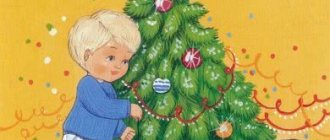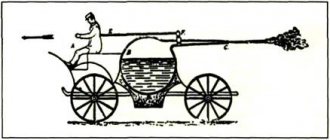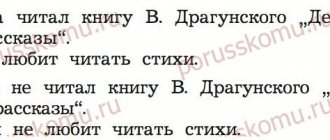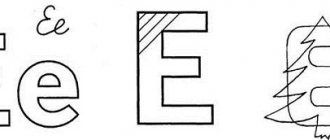Retelling
One day a zoo came to London. To get there, you had to pay money or bring a small animal to feed the animals.
One person picked up a dog on the street to look at the zoo animals. This poor thing was thrown into a lion's cage. But he did not eat her, but on the contrary, made friends with her.
The lion and the dog did everything together: they ate, played, slept. One day a man came to the zoo and saw his dog in a lion’s cage, which had disappeared. He wanted to take her and asked the owner of the zoo about it. He agreed to give it up and tried to take the dog out of the cage, but the lion did not allow him to do this. He bristled and growled.
They lived like this for a year. And trouble happened: the dog died. The lion was very sad for his loss, did not eat anything, touched her with his paw, roared, lashed himself on the sides with his tail, and gnawed the floor. They wanted to take the dead dog out of the cage, but he did not let anyone near it. The zoo owner decided that if he gave the lion a new dog, he would forget that one. But the lion immediately tore her to pieces.
Then he lay down next to the dead dog, hugged it with his paw, and lay there for five whole days. The next day the lion died.
Lesson summary “The Lion and the Dog”
Lesson summary on literary reading. L.N. Tolstoy “The Lion and the Dog”. 3rd grade of educational complex “School of Russia”.
FULL NAME. teachers
: Chvanova Svetlana Vladislavovna.
Class
: 3rd grade
Author of teaching materials (training course program):
Literary reading grade 3 (“Russian School”) L.F. Klimanova, V.G. Goretsky. M.: Enlightenment (textbook 2013)
Item:
literary reading
Subject:
L.N. Tolstoy "The Lion and the Dog".
Lesson type:
acquisition of new knowledge.
Target:
formation of educational competencies (informational, communicative, creative, reflective) of grade 3 “B” students in the subject area of literary reading on the topic: L.N. Tolstoy “The Lion and the Dog.”
Lesson learning objectives:
1. Learning objectives aimed at achieving personal results:
Formation of positive self-esteem, self-esteem;
Development of cooperation skills with adults and peers in different social situations;
Development of ethical feelings, goodwill and emotional responsiveness.
2. Learning objectives aimed at achieving meta-subject learning outcomes: (regulatory, communicative, cognitive learning outcomes)
1) formation of the ability to accept and maintain an educational task, plan, control and evaluate educational actions in accordance with the task and the conditions for its implementation, the formation of initial forms of cognitive and personal reflection;
2) developing the ability to competently construct verbal statements in accordance with the tasks of communication, listen and hear the interlocutor, conduct a dialogue, clearly and clearly state your point of view and argue for it, the ability to interact in static pairs and groups.
3) development of the ability to actively use speech means and means of information and communication technologies to solve communicative and cognitive problems, development of thinking operations to solve problem situations.
3. Learning objectives aimed at achieving subject-specific learning outcomes:
1) development of reading skills: reading whole words, error-free reading, expressive reading;
2) developing the ability to consciously perceive and evaluate the content of texts, participate in their discussion, give and justify a moral assessment of the actions of the heroes;
3) the formation of initial ethical ideas, concepts of goodness, friendship, love; developing the need for systematic reading;
4) development of creative abilities.
Forms of student work:
individual, frontal, pair, group
.
Necessary technical equipment: board, computer, projector.
Org. moment
The bell rang for our lesson. Good morning, children! Good morning, guests! May this morning bring us the joy of communication and fill our hearts with noble feelings. The most amazing thing in the world is human kindness. Give each other smiles. Convey your good mood.
Conversation with older children. L. N. Tolstoy “The Lion and the Dog”
Conversation with older children.
L. N. Tolstoy “The Lion and the Dog”
The story that L.N. Tolstoy will tell us about happened a long time ago, in the city of London, far from the shores of Russia. Perhaps some sailor who had been there told him about this story. Who knows. But the fact is that little Tolstoy was very sensitive - when he listened to sad stories or saw, for example, a dead bird, a kitten with a broken leg, he cried. This trait of compassion remained in him until the end of his life.
How do you understand the word “compassion”? (the ability to feel someone else’s pain, worry and sympathize.)
I would like you to experience this feeling today. After all, only a person with a sensitive heart can empathize, rejoice, be sad, and grieve.
We will see the theme of compassion in the new work of L. N. Tolstoy.
Let's find out more about these animals
Dog: our most faithful pet friend. Seven thousand years ago, man tamed the dog. A dog helps a person in hunting, and in the household protects the home and livestock. There are more than 400 dog breeds: mastiff, English bulldog, boxer, German shepherd, St. Bernard, Russian greyhound. Many representatives of these breeds help save people and warm them with their bodies. Smallest dog in the world? Chihuahua. Her height is 15-20cm.
Lion is the king of the animals. He looks up somewhere, as if not noticing you. A lion has a mane, but a lioness does not have a mane. The mane indicates the power of the lion: it is both his scepter and his power. Doesn't the lion roar? "thunder from heaven" He can crawl on his belly and even hide in short grass so that you won’t notice him. A lion can reach speeds of up to 50 km/h. Can climb trees. The king of beasts gives way to adult rhinoceroses, elephants, hippopotamuses, and is wary of them. Is the lion the strongest of all? It turns out not. In a fight with a tiger, the lion is inferior to him in strength.
- Guys, what do you think? Can a dog and a lion be friends? (children's answers)
Listen to the story
“Lion and dog."
In London they showed wild animals and for viewing they took money or dogs and cats to feed the wild animals. One man wanted to see the animals: he grabbed a little dog on the street and brought it to the menagerie. They let him in to watch, but they took the little dog and threw him into a cage with a lion to be eaten. The dog tucked its tail and pressed itself into the corner of the cage. The lion came up to her and smelled her. The dog lay down on its back, raised its paws and began wagging its tail. The lion touched it with his paw and turned it over. The dog jumped up and stood on its hind legs in front of the lion. The lion looked at the dog, turned his head from side to side and did not touch it. When the owner threw meat to the lion, the lion tore off a piece and left it for the dog. In the evening, when the lion went to bed, the dog lay down next to him and put her head on his paw. Since then, the dog lived in the same cage with the lion, the lion did not touch her, ate food, slept with her, and sometimes played with her. One day the master came to the menagerie and recognized his dog; he said that the dog was his own, and asked the owner of the menagerie to give it to him. The owner wanted to give it back, but as soon as they began to call the dog to take it from the cage, the lion bristled and growled. So the lion and the dog lived for a whole year in the same cage. A year later the dog got sick and died. The lion stopped eating, but kept sniffing, licking the dog and touching it with his paw. When he realized that she was dead, he suddenly jumped up, bristled, began to whip his tail on the sides, rushed to the wall of the cage and began to gnaw at the bolts and the floor. All day long he struggled, thrashed about in the cage and roared, then he lay down next to the dead dog and fell silent. The owner wanted to take away the dead dog, but the lion would not let anyone near it. The owner thought that the lion would forget his grief if he was given another dog, and let a live dog into his cage; but the lion immediately tore it into pieces. Then he hugged the dead dog with his paws and lay there for five days. On the sixth day the lion died.
Lesson on literary reading by L. Tolstoy “The Lion and the Dog”, 3rd grade, educational complex “Primary school of the XXI century”
Reading with stops.Read to the words: “... thrown into a lion’s cage to be devoured”
-Why did the man catch the dog and bring it to the menagerie? Find and read the answer to the question. (For watching wild animals they took money or animals (cats or dogs) to feed the animals. This man had no money, but he wanted to look at the animals in the menagerie.)
-How can you evaluate such behavior of people? What can you call such people? Can we call them cruel?
— How was the cruelty of people expressed in this work? What did people do with animals? Did they act fairly? What are animals compared to? (Cats, dogs and money are equal. In the text, these words are connected by the conjunction “or”. If there is no money, then domestic animals, human friends, can be given to feed wild animals.)
grabbed in the text
.
Read the entire sentence. Choose a synonym for the word grabbed. (catch)
-Why did the author use this particular word, and not catch what shade of meaning is important to him? (Grabbed means he acted thoughtlessly, accidentally grabbed something that came to hand, i.e. the person did not care who came into his hand).
Read to the words: “... and laid her head on his paw.”
-Look at the illustration on the slide
What moment does it refer to? What do the animals look like? ( This illustration refers to the moment when the lion and the dog went to bed. The lion looks serious, proud, the dog looks calm, peaceful).
- What sentence would you sign under this illustration? (Friendship between a lion and a dog)
—What would you call the relationship between a lion and a dog?
- What other sentence convinces us that the dog and the lion have become friends? (when the owner threw meat to the lion, the lion tore off a piece and left it for the dog).
-Now let's find out why they became friends ? (The dog interested the lion)
— In his work, L.N. Tolstoy did not describe in detail either the appearance of the dog and the lion, or their experiences. But he talked a lot about the behavior of these animals.
- Find and read the words about how the dog behaved when meeting a lion . (the dog tucked its tail and pressed itself into the corner of the cage, the dog lay on its back, raised its paws and began waving its tail, the dog jumped up and stood on its hind legs in front of the lion)
-Why didn’t the lion tear the dog to pieces, but became interested in it? What surprised him about the dog’s behavior? Let's try to decipher the dog's language.
- She tucked her tail, pressed herself into the corner of the cage - ? (fear)
Guys, was she scared, happy or angry?
- wags his tail - ? (friendliness)
Guys, when a dog wags its tail, what does it mean? Is she happy, afraid or angry?
-lay down on your back - ? (confidence)
Guys, animals' weakest point is their stomach. In any danger, the animal tries to hide its belly. What conclusion can we draw as to why the dog lay on its back?
- stood on her hind legs - ? (submissiveness, devotion)
Guys, was she scared, happy or angry?
-What did the dog tell the lion with his behavior? (that she wants to be friends with the lion, is not afraid of him).
Read to the words: “So the lion and the dog lived for a whole year in the same cage.”
-Why do you think the story about a whole year of life fits in one sentence? Guys, where were our main characters? ( in a cage). Were they allowed out for a walk? (No). What were they doing in the cage? (looked at visitors, ate meat, slept, played). Do you think our heroes fought? (No). What conclusion can we draw? (Life in a cage in captivity is neither fun nor particularly eventful)
Read to the end
-Find and read an excerpt from the text about how the lion experienced the death of the dog? (The lion stopped eating, but kept sniffing, licking the dog and touching it with his paw. When he realized that she was dead, he suddenly jumped up, bristled, began to whip his tail on the sides, rushed to the wall of the cage and began gnawing on the bolts and the floor. All day long he fought, tossed about in the cage and roared, then lay down next to the dead dog and fell silent. The owner wanted to take the dead dog away, but the lion did not let anyone near it).
-How does a lion feel when he loses his dog? (Hopelessness, he doesn’t know how to get his friend back.)
-What words does the author use to convey the feelings of the lion? Read it. (He suddenly jumped up, bristled, and began to whip
himself with his tail on his sides,
rushed
to the wall of the cage and
began gnawing
on the bolts and the floor.
The whole day he fought
,
tossed about
in the cage and
roared
, then he lay down next to the dead dog and fell silent.)
- Guys, what does “bristled” mean? (Raise the fur, stubble on the back, preparing to defend or attack)
-How do you understand the word “beat”? (He fought - he hit, he pounded, he made sudden movements).
-How do you understand the word “rushed”? (Tossed about - moved restlessly from side to side)
-Verbs help us understand the hero’s experiences.
-Why doesn’t the lion accept the new dog ? (They don’t change friends, he was devoted to her).
- Leo was a devoted friend, therefore, shocked by the death of the dog, he died, surviving her by several days.
- We were just talking about animals: a wild predator - a lion and a small dog. We analyzed their behavior and relationships.
— Answer the question I asked at the beginning of the lesson: can they experience feelings in the same way as a person?
-Yes, animals are capable of experiencing deep feelings (friendship, loyalty...) that we are used to seeing in people.
-How did the people behave in the story “The Lion and the Dog”? What words can we use to describe their actions? People behaved differently. Find a passage in the text that says that people were cruel....., indifferent....., full of remorse...., felt pity......
In London they showed wild animals and for viewing they took money or dogs and cats to feed the wild animals.
| cruelty | |
| One man wanted to see the animals: he grabbed a little dog on the street and brought it to the menagerie. | indifference |
| One day the master came to the menagerie and recognized his dog; he said that the dog was his own, and asked the owner of the menagerie to give it to him. | repentance |
| The owner thought that the lion would forget his grief if he was given another dog, so he let a live dog into his cage. | a pity |
-How would you behave in such a situation? Would you give a dog to a lion in order to see the animals for yourself? What other feelings could humans and animals experience? And if everything had turned out differently, what feelings would we experience?
-So, L. Tolstoy showed in the story how completely different animals, in size, lifestyle, character, can experience deep and strong feelings for each other. This story proves to us that animals, just like people, have a heart, they understand everything, feel what is happening, worry, and can be attentive and caring to each other. Very often they turn out to be wiser, more sensitive, kinder and more loyal than a person.
-And the lion’s behavior is a lesson to people. A lesson in kindness, loyalty, devotion. This amazing story about animals helps us, people, understand that friendship is a great miracle. Friendship is needed by everyone living on our planet, because everyone needs mutual understanding, protection and help.




